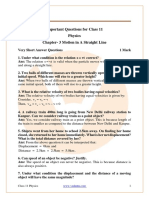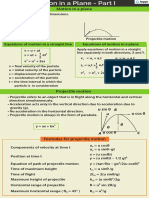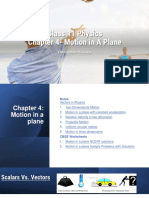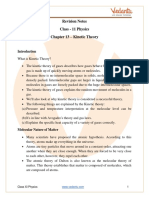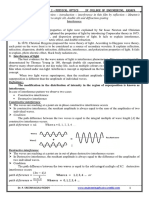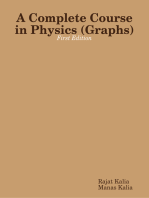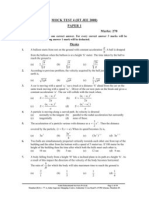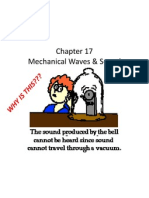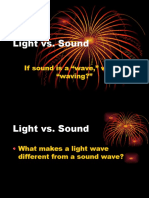PH 11 Waves Notes
PH 11 Waves Notes
Uploaded by
Tikeshwar SharmaCopyright:
Available Formats
PH 11 Waves Notes
PH 11 Waves Notes
Uploaded by
Tikeshwar SharmaOriginal Description:
Original Title
Copyright
Available Formats
Share this document
Did you find this document useful?
Is this content inappropriate?
Copyright:
Available Formats
PH 11 Waves Notes
PH 11 Waves Notes
Uploaded by
Tikeshwar SharmaCopyright:
Available Formats
IB Physics Waves
Waves Introduction
A wave is a disturbance in a medium that caries energy without a net movement of particles. A wave: transfers energy. usually involves a periodic, repetitive movement. does not result in a net movement of the medium or particles in the medium (mechanical wave). There are some basic descriptors of a wave. Wavelength () is distance between an identical part of the wave. Amplitude is maximum displacement from neutral position. This represents the energy of the wave. Greater amplitude carries greater energy. Displacement is the position of a particular point in the medium as it moves as the wave passes. Maximum displacement is the amplitude of the wave. Frequency () is the number of repetitions per second in Hz, s-1 Period (T) is the time for one wavelength to pass a point. T = -1 The velocity (v) of the wave is the speed that a specific part of the wave passes a point. The speed of a light wave is c. We will deal with two types of waves: A transverse wave has the motion of the medium perpendicular to the movement of the wave pulse. A longitudinal wave has the motion of the medium parallel to the movement of the wave pulse. For most waves, the particles of the medium move in a repetitive way that results in no net displacement. A transverse wave has the displacement of the particles in the medium moving perpendicular to the direction of the waves movement
IB Physics Waves Examples of transverse waves: Water waves (ripples of gravity waves, not sound through water) Light waves S-wave earthquake waves Stringed instruments Torsion wave The high point of a transverse wave is a crest. The low part is a trough. A longitudinal wave has the movement of the particles in the medium in the same dimension as the direction of movement of the wave. Examples of longitudinal waves: Sound waved P-type earthquake waves Compression wave Longitudinal waves create areas of compression where particles are pushed together (higher density), and rarefaction where particles are pulled apart (lower density) Sound waves are often represented by a transverse wave (sinusoidal wave). Both a transverse and longitudinal wave can be described with a displacement time graph. Why?
If a single point of the medium is examined over time, its motion will be periodic.
IB Physics Waves The displacement position graph takes a picture of the medium at a specific time. The displacement is for the medium. The position is for the progress of the wave. Why does the same graph describe both types of waves?
As a wave passes a point, the speed of the wave will be measured by the repeated motion. If the time is measured between two crests in a wave, the speed is the wavelength divided by the period. Ex 1: A person is standing on a dock. The person starts a clock as one crest passes them. As the fifth crest passes, the watch reads 3.5 s. A crest takes 4.7s to pass along the 3.2 m of the dock. What can you describe quantitatively about the wave?
v=
! =!f T
p. 386, 15, 17, 19, 21 pp. 396-398, 44-48, 50, 75, 77, 79, 81, 83
IB Physics Waves
Waves One dimensional Waves
We will examine one dimensional waves such as a transverse wave on a rope or spring, and longitudinal waves on a spring (slinky). As a mechanical wave reaches the end of its medium, it will reflect. The energy it contains will not just disappear. The reflection will vary for a hard (fixed) boundary, and for a soft (flexible or movable) boundary. The reflected wave will be upright for a soft boundary, and inverted for a fixed boundary.
A wave that reaches a change in its medium, will be have its speed changed as it passes into the new medium (refraction), and it will also reflect at the new medium (a type of boundary). Traveling into a slower medium is like a hard boundary. Traveling into a faster medium is like a soft boundary. Watch the speed of the refracted wave, and the nature of the reflected wave .
IB Physics Waves If a continuous wave is moving along a rope, and is reflected, the wave will pass over itself. Two waves at the same point are combined by the principle of superposition.
Superposition
The displacement of each wave is added together to determine the displacement of the combined wave. The two waves are interfering with each other. Destructive interference occurs if a positive displacement and a negative displacement add together to make a smaller (or zero) displacement. Constructive interference occurs if a two displacements that are the same combine to make a larger displacement. This applet shows different types of sine waves interfering. Sketch examples of constructive and destructive interference.
IB Physics Waves A reflected wave will interfere with itself and form a specific pattern. This pattern is called a standing wave. Note the differences between the type of reflection, and the differences in the standing wave that forms. Nodes are the points of zero displacement. Anti-nodes are points of maximum displacement.
A standing wave can be created whenever a continuous wave interferes with another continuous wave of the same frequency and wavelength. A standing wave is made up of moving waves. The phenomenon that results looks as if it is standing. pp. 396-399, 52-57, 67, 68, 84, 87
IB Physics Waves
Waves Standing Sound waves
A sound wave is a longitudinal wave that is often drawn as a transverse sine wave. Standing sound waves are used in musical instruments. An instrument resonates. If an object can vibrate at a natural frequency, it can resonate if an oscillation causes it to vibrate at its natural frequency. The resonating object will amplify the affect of the original vibration. A musical instrument has a method to vary its resonant frequency. Resonance is an example of a standing wave. This wave can be of various harmonics. A harmonic describes how many standing waves are present. We will examine resonant standing waves in two situations: strings and pipes with air. A standing wave is a wave that is traveling back and forth and reflecting on a medium. The boundary conditions are important because it affects the way that the wave reflects. We will start with situations with both ends (reflection points) are hard reflectors (fixed): sinusoidal, longitudinal For a standing wave, this means the fixed ends will form a node. This is used in stringed instruments. The fundamental has a length of 1 = 2l v v f1 = = !1 2l For second harmonic: 2 = 2/2l,
f2 = v v = !2 l
For the nth harmonic: n = 2/nl,
fn =
v nv = !n 2l
A pipe that is open at both ends, will form a standing wave with a soft reflection at both ends. The formulas to calculate the frequencies are the same as for a double closed pipe. Why?
IB Physics Waves A pipe with one end closed is the most common for instruments. It had one hard reflection and one soft reflection. The first harmonic has a node at the closed end and an anti-node at the open end. 1 = 4l The fundamental has a length of 1 = 4l
f1 =
v v = !1 4l
For first harmonic: 2 = 4/3l,
f2 = v 3v = !2 4l
For the nth harmonic: n = 4/2nl,
fn =
2n " 1 v v = !n 4l
How does a pipe organ have different harmonics for different notes?
How does a flute or a trumpet have different harmonics for different notes?
What is the sweet spot on a bat or club?
IB Physics Waves
Doppler Effect
Frequency of a wave can also vary due to the movement of the source of the wave or the receiver of the wave. If the source or receiver of a wave are moving together, the wave will decrease its wavelength and increase its frequency. If the source or receiver are moving apart, the wavelength will be longer and the frequency will be lower.
The Doppler effect also applies to light. A star that is moving towards us will have its light observed at a higher frequency (blue shift). A star that is moving away from us has its light observed at a longer wavelength (red shift). This lets us judge the speed of a star based on the red or blue shift of the spectral lines in the light from that star.
A potentially dangerous application of the Doppler effect occurs when an object travels at the speed of sound. A layer of compressed air develops just in front of the object. The sound wave can not get ahead of the object. In order for the object (airplane) to pass through this pressure wave, there must be adaptations made to the plane. pp. 424-427, 31, 34, 35, 37, 38, 41, 45, 48, 50, 51, 54, 57, 62, 71, 75, 76, 77,
IB Physics Waves
Waves Two dimensional waves
Two dimensional waves behave according to the same rules as one dimensional waves; however, the applications can be more complex. We will examine water waves initially to discuss two dimensional waves. A two dimensional wave is drawn by showing the wave crests and/or the direction of the waves motion. The simplest wave is from a point source. The wave spreads in all directions radially from the source. Water waves move in wave fronts. One example of a wave front is a linear wave.
One model to think about a linear wave is called Huygens Principle. Huygen suggested that each point in a wave crest should be considered a point source. As the point sources combine, the sideways parts are cancelled out, and the forward part combine to form the wave front.
10
IB Physics Waves The activity you are going to complete today will require you to sketch the ripples in a wave tank in several different circumstances. You will have to explain what you observe based on Huygens principle and what you know about waves. Water waves propagates more slowly in shallow water.
In an oblique refraction, part of the wave slows before the rest of the wave. If part of the wave slows, the wave will change direction. How can you simulate this with people walking in a line?
11
You might also like
- Toby Crabel - Day Trading With Short Term Price Patterns and Opening Range Breakout PDFDocument299 pagesToby Crabel - Day Trading With Short Term Price Patterns and Opening Range Breakout PDFTikeshwar Sharma100% (1)
- CSWIP 3.4U - Underwater Inspection ControllerDocument532 pagesCSWIP 3.4U - Underwater Inspection Controllerkirubha_karan200089% (9)
- Grade 11 Waves and Sound Lesson PlanDocument4 pagesGrade 11 Waves and Sound Lesson Planapi-272399401100% (1)
- Mechanical Properties of SolidsDocument37 pagesMechanical Properties of SolidsRahul Pugazhendi100% (1)
- Relative MotionDocument14 pagesRelative MotionSunil DasNo ratings yet
- SSLC Wave Motion Kerala English MediumDocument6 pagesSSLC Wave Motion Kerala English MediumAKHILSTNo ratings yet
- Waves Class 11 Notes Physics Chapter 15 - Learn CBSEDocument9 pagesWaves Class 11 Notes Physics Chapter 15 - Learn CBSERishabh Singh RajputNo ratings yet
- class 11 -WavesDocument14 pagesclass 11 -WavesMohammed IliasNo ratings yet
- Mechanical Properties of FluidsDocument5 pagesMechanical Properties of FluidsSteveMathewKuruvillaNo ratings yet
- Class 11 CH 4 Circular MotionDocument3 pagesClass 11 CH 4 Circular MotionHarsh TripathiNo ratings yet
- Physics Notes Class 11 Chapter 4 Motion in A Plane Part 1Document8 pagesPhysics Notes Class 11 Chapter 4 Motion in A Plane Part 1ShashankAnil50% (2)
- Law of Motion Class 11 Notes Physics Chapter 5Document13 pagesLaw of Motion Class 11 Notes Physics Chapter 5pujal dabasNo ratings yet
- 8 - Atoms and Nuclei PDFDocument25 pages8 - Atoms and Nuclei PDFthinkiit67% (3)
- Physics Notes Class 11 CHAPTER 13 KINETIC THEORY With SOLUTIONSDocument6 pagesPhysics Notes Class 11 CHAPTER 13 KINETIC THEORY With SOLUTIONSSk ShivamNo ratings yet
- Moving Charges & MagnetismDocument72 pagesMoving Charges & MagnetismAhmed FirasNo ratings yet
- Physics Notes Class 11 Chapter 4 Motion in A Plane Part 1Document8 pagesPhysics Notes Class 11 Chapter 4 Motion in A Plane Part 1TajiriMollel50% (2)
- Mechanical Properties of Solids PPTDocument19 pagesMechanical Properties of Solids PPThpsgam112233No ratings yet
- CBSE Class 11 Physics Chapter 3 - Motion in A Straight Line Important Questions 2022-23Document33 pagesCBSE Class 11 Physics Chapter 3 - Motion in A Straight Line Important Questions 2022-23Arpan SainiNo ratings yet
- 11 Chemistry Notes Chapter 3Document13 pages11 Chemistry Notes Chapter 3Gyani ChachaNo ratings yet
- Chapter No 1Document26 pagesChapter No 1Moin Khan100% (2)
- Black Body RadiationDocument12 pagesBlack Body RadiationMahesh Lohith K.S100% (4)
- Important Questions For Class 11 Physics Chapter-14 OscillationsDocument43 pagesImportant Questions For Class 11 Physics Chapter-14 Oscillations10B Zoya GousNo ratings yet
- Free Electron TheoryDocument8 pagesFree Electron TheoryNeelam KapoorNo ratings yet
- CBSE Class 11 Physics - Gravitation NotesDocument9 pagesCBSE Class 11 Physics - Gravitation NotesAyush GoelNo ratings yet
- GravitationDocument45 pagesGravitationthinkiit100% (1)
- Adsorption and Colloids Notes Class 11 ChemistryDocument28 pagesAdsorption and Colloids Notes Class 11 Chemistrywariit20250% (1)
- Atom and Its Structure Class 11 Notes NEET Chemistry (PDF)Document11 pagesAtom and Its Structure Class 11 Notes NEET Chemistry (PDF)Ankit KumarNo ratings yet
- Mechanical Properties of SolidsDocument29 pagesMechanical Properties of SolidsManas ThakurNo ratings yet
- Motion in A PlaneDocument3 pagesMotion in A PlanePilotsaicharan AirbusNo ratings yet
- NCERT Exemplar For Class 11 Chemistry Chapter 8 - Redox Reactions (Book Solutions)Document22 pagesNCERT Exemplar For Class 11 Chemistry Chapter 8 - Redox Reactions (Book Solutions)jackdish18No ratings yet
- CBSE Class 11 Physics Chapter 9 - Mechanical Properties of Solids Important Questions 2022-23Document49 pagesCBSE Class 11 Physics Chapter 9 - Mechanical Properties of Solids Important Questions 2022-23Fennix AGNo ratings yet
- Phy - NLM PDFDocument48 pagesPhy - NLM PDFKushagraNo ratings yet
- Chapter 4 - Motion in A PlaneDocument30 pagesChapter 4 - Motion in A PlaneHakim Abbas Ali PhalasiyaNo ratings yet
- Revision Notes Class - 11 Physics Chapter 13 - Kinetic TheoryDocument23 pagesRevision Notes Class - 11 Physics Chapter 13 - Kinetic TheoryAngel KuttyNo ratings yet
- Motion in A Plane-01Document30 pagesMotion in A Plane-01wixirepNo ratings yet
- 10 Mechanical Properties of FluidsDocument17 pages10 Mechanical Properties of FluidsPavan KumarNo ratings yet
- Spectroscopy - Rotational Spectroscopy - Wikiversity PDFDocument36 pagesSpectroscopy - Rotational Spectroscopy - Wikiversity PDFKishore KishoreNo ratings yet
- Current Electricity (Theory)Document8 pagesCurrent Electricity (Theory)arshz100% (1)
- Class 11 Physics Term 1 Most Imp QuestionsDocument7 pagesClass 11 Physics Term 1 Most Imp QuestionsSANJAY PARMARNo ratings yet
- System of Particles and Rotational MotionDocument10 pagesSystem of Particles and Rotational MotionpkmuhsinNo ratings yet
- Class Xi Physics Annual Exam 2017 18Document3 pagesClass Xi Physics Annual Exam 2017 18Anupam TiwariNo ratings yet
- 1 Rotational Dynamics PDF PrintDocument22 pages1 Rotational Dynamics PDF PrintHarshal Mankar0% (1)
- Chapter 3 Motion in A Plane CompressedDocument24 pagesChapter 3 Motion in A Plane CompressedRAJIV GOELNo ratings yet
- Chapter 3 Motion in A Straight LineDocument50 pagesChapter 3 Motion in A Straight LineNitish MehraNo ratings yet
- CBSE Class 11 Physics Chapter 10 - Mechanical Properties of Fluids Important Questions 2022-23Document91 pagesCBSE Class 11 Physics Chapter 10 - Mechanical Properties of Fluids Important Questions 2022-23Iron ManNo ratings yet
- A Fortran 90 Program To Solve A Set of Linear Equations by UsingDocument3 pagesA Fortran 90 Program To Solve A Set of Linear Equations by Usingnadher albaghdadiNo ratings yet
- Degree of Freedom PDFDocument13 pagesDegree of Freedom PDFAnas0% (1)
- Questions Bank On ELECTROSTATICSDocument3 pagesQuestions Bank On ELECTROSTATICSAlok ShawNo ratings yet
- Important Questions For CBSE Class 11 Physics Chapter 4Document39 pagesImportant Questions For CBSE Class 11 Physics Chapter 4lavanya rajaNo ratings yet
- Chapter No 4Document27 pagesChapter No 4Moin KhanNo ratings yet
- System of Particles & Rotational Motion: Chapter - 00Document32 pagesSystem of Particles & Rotational Motion: Chapter - 00Raichal P BijuNo ratings yet
- 1a. Work Power Energy - Synopsis (1-29)Document29 pages1a. Work Power Energy - Synopsis (1-29)syedphy4272100% (1)
- Wave Optics (Xiii) Teaching NotesDocument16 pagesWave Optics (Xiii) Teaching NotesSankar KumarasamyNo ratings yet
- Class 11 Physics Practice PaperDocument3 pagesClass 11 Physics Practice PapereltytanNo ratings yet
- Class 12 Physics Notes CBSE BOARD Download Chapter 6 ELECTROMAGNETIC I NDUCTIONDocument7 pagesClass 12 Physics Notes CBSE BOARD Download Chapter 6 ELECTROMAGNETIC I NDUCTIONRUDRAKSH FFNo ratings yet
- Structure of AtomDocument72 pagesStructure of AtomAditi Yadav100% (1)
- OSCILLATIONS PPTDocument26 pagesOSCILLATIONS PPTkhatrisavita1981No ratings yet
- SVCK - Physical OpticsDocument12 pagesSVCK - Physical OpticsHarsh DeoNo ratings yet
- Motion in A Plane PDFDocument18 pagesMotion in A Plane PDFRohitNo ratings yet
- Hydrocarbons Chemistry NotesDocument29 pagesHydrocarbons Chemistry NotesBhavesh K100% (1)
- Laws of Motion - Class 11 JEEDocument19 pagesLaws of Motion - Class 11 JEEPrince Roy MondalNo ratings yet
- Waves and LightDocument21 pagesWaves and LightTheEinsteinofTomorrowNo ratings yet
- Concept of Accid and BasesDocument25 pagesConcept of Accid and BasesTikeshwar SharmaNo ratings yet
- Unit 6 Binomial TheoremDocument28 pagesUnit 6 Binomial TheoremTikeshwar SharmaNo ratings yet
- WORK BOOK - Exercise in ChemistryDocument28 pagesWORK BOOK - Exercise in ChemistryTikeshwar SharmaNo ratings yet
- Assertion ND Reason Problems in Math For IITDocument76 pagesAssertion ND Reason Problems in Math For IITavs0% (1)
- Mock Test Iit - Jee..Paper 1Document10 pagesMock Test Iit - Jee..Paper 1Tikeshwar SharmaNo ratings yet
- Mock Test Iit - Jee..Paper 1Document10 pagesMock Test Iit - Jee..Paper 1Tikeshwar SharmaNo ratings yet
- Pile Foundations in Engineering Practice by S - by Civildatas - Blogspot.inDocument784 pagesPile Foundations in Engineering Practice by S - by Civildatas - Blogspot.inTatiana RodríguezNo ratings yet
- Unit 4.1 Wave MotionDocument18 pagesUnit 4.1 Wave MotionhahaNo ratings yet
- Tests and Acceptance Criteria For Concrete Based On Compressive Strength by Diwan Singh Bora IDSEDocument9 pagesTests and Acceptance Criteria For Concrete Based On Compressive Strength by Diwan Singh Bora IDSEArindam NandyNo ratings yet
- Chapter 17 NotesDocument72 pagesChapter 17 Notesapi-30718309No ratings yet
- Wave Motion ScienceDocument14 pagesWave Motion ScienceFredroNo ratings yet
- PHSC2112 Q2 Written Work 1Document6 pagesPHSC2112 Q2 Written Work 1RussianOmeleteNo ratings yet
- Normal Incidence Shear Wave TransducersDocument3 pagesNormal Incidence Shear Wave Transducerscal2_uniNo ratings yet
- Lecture Powerpoint: Physics: Principles With Applications, 6 EditionDocument57 pagesLecture Powerpoint: Physics: Principles With Applications, 6 EditiontortomatoNo ratings yet
- Physics RevisionDocument7 pagesPhysics RevisionFurret MasterNo ratings yet
- Quiz 1 Science 10Document3 pagesQuiz 1 Science 10rangel rotaNo ratings yet
- Ch02-Zealey PRE 4thppDocument67 pagesCh02-Zealey PRE 4thppMuhammad Kashif RashidNo ratings yet
- Mathematics, Science, and TechnologyDocument6 pagesMathematics, Science, and Technologyfrederick liponNo ratings yet
- Unit 9 Sound: Summary QuestionsDocument2 pagesUnit 9 Sound: Summary QuestionsShunasiNo ratings yet
- Li-Feng Ge - Solid Acoustic Waves and Vibration - Theory and Applications (2021, WSPC) - Libgen - LiDocument444 pagesLi-Feng Ge - Solid Acoustic Waves and Vibration - Theory and Applications (2021, WSPC) - Libgen - LiThiago VicznevskiNo ratings yet
- Dynamic Poisson's Ratio of Portland CementDocument25 pagesDynamic Poisson's Ratio of Portland CementJelena MarkovićNo ratings yet
- Weekly Learning Activity SheetsDocument9 pagesWeekly Learning Activity Sheetsjoan marie PeliasNo ratings yet
- 3.3.1.2 Longitudinal and Transverse WavesDocument37 pages3.3.1.2 Longitudinal and Transverse Wavessara patwardhanNo ratings yet
- NDT (Rebound and Pulse Velocity)Document34 pagesNDT (Rebound and Pulse Velocity)er.praveenraj30No ratings yet
- WaveDocument17 pagesWaveJevanthe Miguel ObusanNo ratings yet
- Longitudinal Wave PPT - 61Document39 pagesLongitudinal Wave PPT - 61jear100% (1)
- Ut Testing ProblemsDocument22 pagesUt Testing Problemsravindra_jivani100% (1)
- Physics XII Old Is Gold Solution PDFDocument331 pagesPhysics XII Old Is Gold Solution PDFAAKASH ChopraNo ratings yet
- (ASME Sec V Article 4 & 5) : UT - Ultrasonic TestingDocument31 pages(ASME Sec V Article 4 & 5) : UT - Ultrasonic Testingvijay vickyNo ratings yet
- PhysicsDocument5 pagesPhysicsMaraim AliNo ratings yet
- Chapter 11 - SoundDocument9 pagesChapter 11 - SounditcellNo ratings yet
- Wave and Thermodynamic DCP PDFDocument464 pagesWave and Thermodynamic DCP PDFAnik Mukherjee100% (1)
- Light Vs SoundDocument15 pagesLight Vs SoundHadi Hassan100% (2)

















